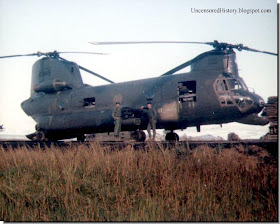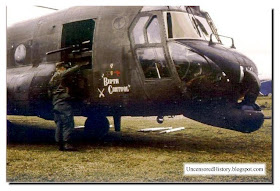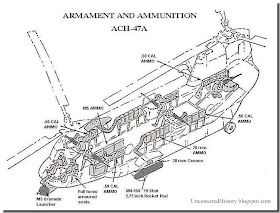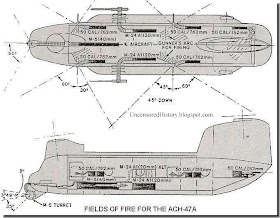THE CHINOOK HELICOPTER
The Army finally settled on the larger Chinook as its standard medium transport helicopter and as of February 1966, 161 aircraft had been delivered to the Army. The 1st Cavalry Division had brought their organic Chinook battalion with them when they arrived in 1965 and a separate aviation medium helicopter company, the 147th, had arrived in Vietnam on 29 November 1965. This latter company was initially placed in direct support of the 1st Infantry Division.
The most spectacular mission in Vietnam for the Chinook was the placing of artillery batteries in perilous mountain positions inaccessible by any other means, and then keeping them resupplied with large quantities of ammunition. The 1st Cavalry Division found that its CH-47s were limited to a 7,000-pound (3,200 kg) payload when operating in the mountains, but could carry an additional 1,000 pounds (450 kg) when operating near the coast. The early Chinook design was limited by its rotor system which did not permit full use of the installed power, and users were anxious for an improved version which would upgrade this system.
As with any new piece of equipment, the Chinook presented a major problem of "customer education". Commanders and crew chiefs had to be constantly alert that eager soldiers did not overload the temptingly large cargo compartment. It would be some time before troops would be experts at using sling loads. The Chinook soon proved to be such an invaluable aircraft for artillery movement and heavy logistics that it was seldom used as an assault troop carrier. Some of the Chinook fleet were used for casualty evacuation, due to the very heavy demand for the helicopters they were usually overburdened with wounded. Perhaps the most cost effective use of the Chinook was the recovery of other downed aircraft.
The CH-47s are generally armed with a single 7.62-millimeter M60 machine gun on a pintle mount on either side of the machine for self-defense, with stops fitted to keep the gunners from firing into the rotor blades. Dust filters were also added to improve engine reliability. At its peak employment in Vietnam, there were 22 Chinook units in operation.
Of the nearly 750 Chinook helicopters in the US and Republic of Vietnam fleets, about 200 were lost in combat or wartime operational accidents. US Army supplied CH-47s to the Australian Task Force as required.
The Army finally settled on the larger Chinook as its standard medium transport helicopter and as of February 1966, 161 aircraft had been delivered to the Army. The 1st Cavalry Division had brought their organic Chinook battalion with them when they arrived in 1965 and a separate aviation medium helicopter company, the 147th, had arrived in Vietnam on 29 November 1965. This latter company was initially placed in direct support of the 1st Infantry Division.
The most spectacular mission in Vietnam for the Chinook was the placing of artillery batteries in perilous mountain positions inaccessible by any other means, and then keeping them resupplied with large quantities of ammunition. The 1st Cavalry Division found that its CH-47s were limited to a 7,000-pound (3,200 kg) payload when operating in the mountains, but could carry an additional 1,000 pounds (450 kg) when operating near the coast. The early Chinook design was limited by its rotor system which did not permit full use of the installed power, and users were anxious for an improved version which would upgrade this system.
As with any new piece of equipment, the Chinook presented a major problem of "customer education". Commanders and crew chiefs had to be constantly alert that eager soldiers did not overload the temptingly large cargo compartment. It would be some time before troops would be experts at using sling loads. The Chinook soon proved to be such an invaluable aircraft for artillery movement and heavy logistics that it was seldom used as an assault troop carrier. Some of the Chinook fleet were used for casualty evacuation, due to the very heavy demand for the helicopters they were usually overburdened with wounded. Perhaps the most cost effective use of the Chinook was the recovery of other downed aircraft.
The CH-47s are generally armed with a single 7.62-millimeter M60 machine gun on a pintle mount on either side of the machine for self-defense, with stops fitted to keep the gunners from firing into the rotor blades. Dust filters were also added to improve engine reliability. At its peak employment in Vietnam, there were 22 Chinook units in operation.
Of the nearly 750 Chinook helicopters in the US and Republic of Vietnam fleets, about 200 were lost in combat or wartime operational accidents. US Army supplied CH-47s to the Australian Task Force as required.
 |
| The ACH-47A Chinook Attack Helicopter in Vietnam |
--------------------------------------------------
TAM HA: THE MAN WHO HELPED AMERICANS TO BEAT OFF THE TET OFFENSIVE ON SAIGON
 |
| Tam Ha was a former Viet Cong political commissar who worked in Radio Mother Vietnam. Just before the Viet Cong launched the May 1968 second phase of their Tet Offensive, Tam Ha came over to the Government side bearing the complete tactical plan for the second VC attempt to “liberate” Saigon. Thanks to him, the U.S. and Vietnamese troops deployed to meet the Viet Cong and successfully beat off their attacks.---http://www.psywarrior.com/VietnamOBPSYOP |
 |
| 1973. A “peace” delegate in Saigon (Tan Son Nhut Airport) en route to Hanoi. To the left is a North Vietnamese soldier strangely carrying a Scottish Plaid suitcase about to board a C-130. In the foreground is a ARVN (Army Republic [South] Vietnam) officer along with a news photographer. http://robertdyoung.blogspot.in/2011_01_23_archive.html |





No comments:
Post a Comment